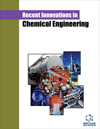- Home
- A-Z Publications
- Recent Innovations in Chemical Engineering (Formerly Recent Patents on Chemical Engineering)
- Previous Issues
- Volume 17, Issue 3, 2024
Recent Innovations in Chemical Engineering (Formerly Recent Patents on Chemical Engineering) - Volume 17, Issue 3, 2024
Volume 17, Issue 3, 2024
- Energy Science, Engineering and Technology, Chemical Engineering
-
-
-
Role of Biomass Gasification in Achieving Circular Economy
More LessGrowing awareness of environmental concerns and the prioritisation of environmental stewardship necessitates the incorporation of sustainability practices that are both economical and profitable. This involves transforming existing industrial practices from the ‘take-make-waste’ approach to one that aligns with the principles of a circular economy. This includes the use and restoration of bioreserves or the cycling of products i Read More
-
-
-
Thermo-Acoustic Behaviour of K2CrO4 and K4 [Fe(CN)6] in Aqueous Dimethylformamide at Different Temperatures
More LessAuthors: Rajalaxmi Panda, Subhraraj Panda and Susanta Kumar BiswalIntroductionAcoustic parameters can help us understand how temperature and concentration affect the behaviour of potassium ferrocyanide and potassium chromate electrolytes in the aqueous solvent Dimethylformamide.MethodsThe solution's density (ρ), viscosity (η), and ultrasonic speed (u) were measured at various concentrations and temperatures (ranging from 293 K to 313 K) using a pycnometer, an Ostwald viscome Read More
-
-
-
Predictive Modeling and Optimization of Plywood Drying: An Artificial Neural Network Approach
More LessIntroductionThis investigation delves into the optimization of the plywood drying process through the development of predictive models for output moisture content (MC_Out) and waviness. It focuses on bridging the gap in current methodologies by employing artificial neural networks (ANNs), optimized with genetic algorithms, to enhance prediction accuracy and process efficiency.Materials and MethodsA comprehensive exper Read More
-
-
-
Regulation of the Properties of Polymers based on Thiirane using Mixtures of Amine Hardeners
More LessAuthors: Yuriy Kochergin, Qing He, Tetiana Hryhorenko and Xiangli MengIntroductionThe possibility of regulating the curing rate and the complex of adhesive, deformation-strength and dynamic mechanical properties of polymers based on bisphenol A dithioester (thiirane) using a mixture of amine hardeners of various chemical nature is investigated.MethodsDiethylenetriamine, diethylenetriaminomethylphenol and aminopolyamide were investigated as hardeners. The rati Read More
-
-
-
Predicting the Residual Strength of Oil and Gas Pipelines Using the GA-BP Neural Network
More LessAuthors: Zhanhui Wang, Mengzhao Long, Wenlong Duan, Aimin Wang and Xiaojun LiBackgroundMost NN (neural network) research only conducted qualitative analysis, analyzing its accuracy, with certain limitations, without studying its NN model, error convergence process, and pressure ratio. There is relatively limited research on the application of NN optimized by GA (genetic algorithm) to oil and gas pipelines; Moreover, the residual strength evaluation of GA-BP NN (genetic algorithm backpropagation neural n Read More
-
Most Read This Month
Article
content/journals/rice
Journal
10
5
false
en


